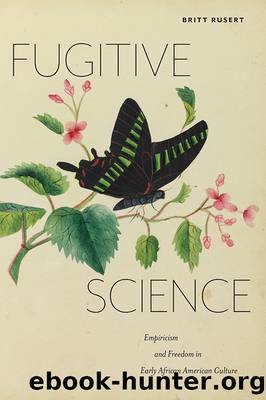Fugitive Science by Britt Rusert

Author:Britt Rusert
Language: eng
Format: epub
Tags: LIT004020 Literary Criticism / American / General
Publisher: NYU Press
Science in/as Performance
The transatlantic performance of fugitive science included both actual performances and the construction of a robust transatlantic imaginary in early African American cultural production, an imaginary enabled by the globally oriented discourses of race in ethnology as well as the travels of African Americans within and outside the United States. During this golden era of popular science, from the 1830s through the 1850s, the connections between black performance and science were many and diverse. In both the United States and Britain, scientists of all kinds competed for audiences with abolitionist lectures and various forms of black performance. At times, such competition produced fascinating forms of intersection, and in the case of racial science, even occasional moments of confrontation. In her study of nineteenth-century craniology, Ann Fabian recounts one such scene in 1830s Philadelphia. One evening, during his 1838 tour of the United States, George Combe arrived to present his lecture at the Philadelphia Museum only to discover that the floor above the lecture hall had been rented to the wildly popular Frank Johnson and his band, recently returned home from a European tour. Johnson was a prominent black composer, bandleader, and musician from Philadelphia, who gained national and international fame for his compositions, especially his dances and military marches. While Combe counted five hundred Philadelphians at his lecture, he reported that Johnsonâs concerts easily drew in some two to three thousand people. To add insult to injury, Combe complained, âThe music is so loud that it often drowns my voice, and when the audience above applaud with their feet, I have no alternative but to stop till they have done.â Fabian uses this scene to demonstrate the competition among entertainers that âcharacterized commercial entertainment in the United States in the 1830s and 1840s.â79 But it is also a beautiful example of black art quite literally interrupting the dominant discourse of antebellum race science. This scene of sonic disruption also troubles our assumptions about the rigid divide between scientific and cultural production in the period.
This scene becomes even more interesting when we consider that Frank Johnsonâs band had just returned home from a European tour that had been a grand success. Johnson and Combe encountered each other in Philadelphia, an important scientific metropole in the United States with substantive connections to other cities where scientific Enlightenment ruled, especially London and Edinburgh. Since scenes like this one were happening on both sides of the ocean, Johnson and Combe could have just as easily encountered one another in Scotland. Throughout the antebellum period, transatlantic black performance regularly confronted and challenged racial science. Frank Johnson was not a scientist, per se, but that night, his music made a significant contribution to the discourse of phrenology, a field with its own complex and vexed relationship to the science of race.
Download
This site does not store any files on its server. We only index and link to content provided by other sites. Please contact the content providers to delete copyright contents if any and email us, we'll remove relevant links or contents immediately.
4 3 2 1: A Novel by Paul Auster(12222)
The handmaid's tale by Margaret Atwood(7637)
Giovanni's Room by James Baldwin(7117)
Asking the Right Questions: A Guide to Critical Thinking by M. Neil Browne & Stuart M. Keeley(5577)
Big Magic: Creative Living Beyond Fear by Elizabeth Gilbert(5557)
Ego Is the Enemy by Ryan Holiday(5228)
The Body: A Guide for Occupants by Bill Bryson(4887)
On Writing A Memoir of the Craft by Stephen King(4823)
Ken Follett - World without end by Ken Follett(4597)
Adulting by Kelly Williams Brown(4438)
Bluets by Maggie Nelson(4431)
Eat That Frog! by Brian Tracy(4387)
Guilty Pleasures by Laurell K Hamilton(4279)
The Poetry of Pablo Neruda by Pablo Neruda(3990)
Alive: The Story of the Andes Survivors by Piers Paul Read(3923)
White Noise - A Novel by Don DeLillo(3915)
Fingerprints of the Gods by Graham Hancock(3899)
The Book of Joy by Dalai Lama(3857)
The Bookshop by Penelope Fitzgerald(3721)
